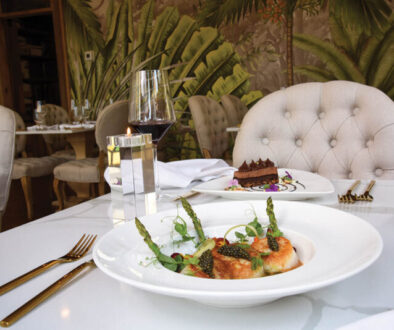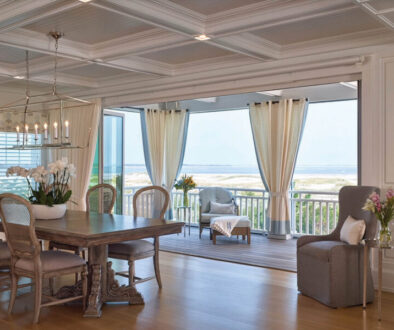The Transformation of 1069: Making a House a Home
Photographs by Elaine Stevensonand Bernie Haas

This article is Part 4 of an ongoing series.
If you haven’t read Part 3, click here to do so now!
After 18 months, while the Covid-19 epidemic continued to stultify economic activity, Elaine Stevenson and her builder “sealed up the envelope” at 1069 Michigan Avenue. The changes to the original 1957 footprint of 1069 Michigan Avenue included reconfiguring the core of the house to make one large great room reinforced with steel beams; connecting the master bathroom to the hall bath; building a new garage aligned with the front of the house to add backyard ground; making space for a laundry area, closets, and a mechanical room; enlarging the second floor to include a full bath and an open hallway to connect two reshaped side-by-side bedrooms; and building a large attic above the garage.
By the end of 2020, 1069 Michigan was watertight and insulated, solid as a rock and ready for the next phase of the project … but the budget was shot.
Reflecting on the thousands of dollars she had to spend to overcome major structural issues—plus design changes like adding two gables in the roof— Elaine knew she had spent a lot more than she wanted. Still, she wasn’t about to second-guess her decisions. With the entire interior to be addressed now, she resolved to be more diligent than ever about spending.
Ever since her first look at the LaMonica house in 2018, there was a constant refrain in her head: “I built my home in North Jersey 20 years ago and I still love it. If I could just pick it up and move it to Cape May, I would!” She did the next best thing: she made it the guiding model for her Cape May residence.




By the time the exterior of 1069 was nearing completion, the parallels between the two houses were remarkable. Each was a one-story ranch house built in the 1950s. They both had been expanded upwards without surrendering the ranch house style. Each had a large bay window in front, chocolate grey mosaic natural stone applied to the exterior and chimney, and a large attached two-car garage with an inside entrance. Essential to each one were sliding glass doors that opened from a great room to a patio and a pool. The two houses weren’t identical enough to be sisters, but they were close enough to be cousins, similar enough that Elaine stopped imagining moving the north house south to Cape May.
Through her work inside the Morris Plains house, she learned what worked for her and what didn’t; but more importantly she knew more precisely what she liked and what she wanted to avoid. So, when it came time to create the look and feel inside of her Cape May home, she already had a sense of the finishes, colors, and hardware details she would choose. And she had established an invaluable list of contacts for advice, and suppliers she could trust.
Perhaps what was reinforced most often was what she learned long before she designed anything: if at first you don’t succeed, try, try again. Still, getting it right the first time is the goal if money is involved. Do-overs abounded so far, but the interior work must be different…
The Morris Plains house has an atmosphere of casual elegance—with a formal, yet comfortable dining room and library. Elaine loves the way the rooms flow one to the next and how her furnishings felt in each one. Could she now impart that same look and feel to the Cape May house, and do it within a tight budget? That was the challenge.
Up to this point, by following the architect’s drawings and Elaine’s insights, the electricians successfully roughed in wiring for switches, outlets, ceiling fans, dimmers, and other controls. Likewise, the HVAC system, complete with multiple units, was fashioned into three individually controlled zones; and the plumbing for four bathrooms, the laundry, an outdoor shower, and garage sink were all ready to go well before drywalling or plastering. What was needed next were decorative fixtures for plumbing and lighting. She saved money by buying faucets, sinks, toilets, and other bathroom hardware online. Capitol Lighting gave her a deep discount for purchasing all the electric fixtures for the house.

Elaine added some special features, a total of six pocket doors like the ones that she had in Morris Plains. Three would be in bathrooms for privacy, one to separate the laundry from the great room, and two pairs of large pocket doors with beveled glass panels to enclose the dining and living rooms, primarily to keep the dogs out. Her plans also included constructing a lighted tray in the ceiling of the master bedroom to include a palm bladed fan in the center. In the same vein, a frame for the tub base enclosure and a recessed shelf in the shower had to be crafted before tiling. These, and a long closet nested into the eaves, were all done by the time the sheet rockers arrived.
The fundamental difference between the north house and 1069 is obvious: The Cape May house is blocks away from the Atlantic Ocean in a seaside resort community. Life near the beach means that sand, humidity, and water are a daily consideration, especially in the warm months. You need an outdoor shower and practical floor finishes. With dogs, a pool, and guests, wall-to-wall carpeting for the common areas would mean unavoidable maintenance problems. Hardwood for the great room, stairs, and upstairs hall was the answer.
Red oak flooring was brought in and acclimated according to the manufacturer’s instructions before installation. However, it must still have contained too much moisture because within days of being installed, it began to buckle, so much so that the builder called in a flooring expert to remove and replace the most egregious areas. Try again? Yes, but that was not the end of the flooring issues.
Once applied, a polyurethane coating sealed the surface; but wood is still vulnerable to scratches and marking until it’s fully cured. Within days of the second coat of finishing, workers covered the floors with tarps to protect the surface; that didn’t do the job. Instead, the cloth tarps moved around on the slippery wood, and particles of debris got between the fabric and the floor, scratching and streaking the surface. The damage was severe enough that Elaine had to re-poly the hardwood in the great room. When it was finished the second time, she personally covered the wood with brown kraft paper, fastened down with painters’ tape. Success. It was a good thing that the four bedrooms got carpeted (“It’s a better feel when you get out of bed”).
All the flooring in the house was replaced except for the living room where the old marble, obtained from the Fox Theater in Philadelphia by a previous owner, remained. It became stained by dirt and debris from above when the roof was open during the reconstruction. A marble restoration expert was hired to refinish it. However, his process did little to change its appearance. Try again? Some other time! An inexpensive area rug helped to disguise the problem for now.



Shortly after the flooring issues were settled, Elaine learned that the four-panel pine doors—22 of them, supplied by the builder—would not accept the stain the men applied without serious blotching. After several more tests and meetings with the supplier and the stain manufacturer, she had to surrender. “Enough! Just paint the doors; time’s wasting!”
Elaine knew that many of the standard finishes like colonial casings and six-panel doors would not fit the overall style of the house. She scoured catalogs and the web to find trim that was contemporary, yet inexpensive. Also, features designed for the trendy casual farmhouse look were not going to cut it.
She wanted to use a variety of ceramic tile for utility and accents. To get good prices for wall and floor tile, she had to shop, sample, order online, and then pick up in person to save time and shipping. To get the eighteen variations of tile she wanted, she found herself doing the Parkway shuffle between Morris County, South Jersey, and Cape May.
One of the biggest challenges in renovating a home is painting. Colorscaping an entire house is not an easy task. The colors need to flow seamlessly from one room to another but not result in every room looking the same. Success is often achieved by starting with one favorite object; in this case it was a large print that would hang in the foyer that literally set the tones for the whole house. A lesson Elaine learned years ago from Canadian designer Lynette Jennings calls for choosing one color from the object as the dominant color (A) in the first room and then picking two other colors for accents—(B) and (C). In the second room, one of the accent colors becomes the dominant one (B), then (A) and (C) become the accents. As you move through the house, the process continues, occasionally picking another color from the object. The actual selections are then fine-tuned to coordinate with existing furniture, cabinetry, floors, and stonework.
Shades of beige are especially tricky as they can look too pink, too yellow, or too brown. The beige tones for the great room, the living room, the downstairs bedrooms, and the kitchen were each different, one to the next. Upstairs the bedrooms were painted a pale blue and a pale green from the same base palette.
To be sure she would buy and paint only once, Elaine applied sample paints to large pieces of cardstock and hung them on the walls in each room to be viewed at various times during the day as the light changed. The sampling worked very well.
The original LaMonica house had a wide enclosed porch that ran across the back of the house from the master bedroom to the edge of the garage. Because she needed ground space for the pool, Elaine had to redesign the back porch by making it much smaller. Following the example of her Morris Plains house, she and the builder fashioned a porch that could be used year-round. Instead of installing large expensive windows with screens, they devised a series of six wooden screen doors, placed in a frame that made up the two outside walls of the porch. Each door came with an interchangeable screen and a glass insert that could be traded out with simple thumb latches—screen in summer, glass in winter.
The same red oak flooring in the main living areas of the house was used on the ceiling of the back porch. Similarly, the tile on the screened porch floor is nearly identical to the patio tile outside and installed using the same pattern. Flow is the key.

In the fashion of the Morris Plains house, Elaine installed a stone fireplace in the great room. After drawing floor plans to see where certain furniture could be placed, she was able to determine that the ventless gas fireplace would work best on the back of the kitchen wall. It was a decision that could be made only once. With the hearth finished—in the same chocolate grey quarry stone as on the front of the house—it was lit for the first time in 2021. The firebox and log set combination proved to be more than enough to heat the great room by itself, if needed.
The new kitchen was made to be the same width as the original, but longer. The counters, equipment, and appliance placements were designed to suit the needs of an amateur gourmet cook. Again following the example of the north house, the plan called for two white Corian topped counters; the larger one a peninsula, big enough for five people to sit on bar stools, so the cook can socialize with guests.
Aware that kitchens can eat up as much as 25 percent of the entire budget of some interior redesigns, Elaine chose middle-of-the-road cabinetry and took advantage of a 30% off sale at Home Depot. She specified maple for the KraftMaid cabinets, and by comparing samples, settled on the Driftwood, a color that coordinated with the stone of the fireplace in the great room.
Elaine wanted to put in a wet bar at the back of the great room, between two pairs of sliding glass doors. It would have coffee and tea stations on a quartzite countertop, complete with a sink. She was looking for a Taj Mahal quartzite remnant and luckily found the right one at Merlino Marble. The builder installed a five-foot cabinet below and a pair of cabinets above that flanked a glass shelf unit. As with the other glass-front cabinets, it too was wired to be lit inside.
For the backsplashes on both sides of the kitchen and behind the wet bar, Elaine wanted mirrored glass. Mirrored glass is perfect for expanding and multiplying the light in a room, but there is no “give” when installing it … ever. With countertop-to-ceiling mirrors in each of the four bathrooms, as well as the backs of the dining room built-in cabinets, she turned to a mirror company for the work—even the pros had a couple of re-installations before it all turned out perfectly. Still, this dent in the budget was worthwhile.
With a couple of generations of glassware to store, the need for cabinets in the formal dining room was obvious. More KraftMaid cabinets, different only in finish from the kitchen, were installed with their own style handles.



Elaine once said that the hardware in a house is the jewelry that gives rooms sparkle. All of the interior doors have handle sets, not knobs, that match the color and finish of the other hardware in the rooms. In the dining room, for example, the polished brass entry door matches the dining room cabinet handles, the window cranks, and polished brass chandelier. The chrome door handle on the kitchen side of the entry door matches the kitchen cabinet handles and faucets.
Finding a broad selection of hardware from which to choose was difficult in South Jersey. Moe Distributors in Morristown, a deceptively large shop, where years ago she examined hundreds of styles and finishes, came to the rescue. She got free advice and ordered plenty of “jewels” to pretty-up the rooms.
When she bought the house two years before, one of the more intriguing things about it was the steel bar that could be dropped into anchors on either side of the front doorway. The idea of “barring the door” was a true reality for a previous owner. Why was it there? No one knew. But it was not part of Elaine’s vision for sure.
The new front doors arrived as a single unit to be installed into the open casement. Each door was six-panel mahogany, an excellent quality that her builder acquired for a good price. The only problem was they were solid, and Elaine wanted more light, especially in the foyer. Before rejecting them outright, she shopped online and in lumber stores, and called references. Glass-paned doors were available from several sources, but none was even close to her budget, especially with shipping. On a trip to Home Depot in Middle Township, she stumbled on the answer. On display was a designer glass insert. It was thick, beveled, and durable with an abstract floral motif. Zabitat, the supplier to Home Depot, contracted to set the glass into the mahogany doors on site. When they were mounted in place, light shown in and sparkled in the foyer. Elaine’s budget was strained, but those glass doors ended up costing less than half of any alternative.
Space by space, room by room, from the front foyer to the enclosed back porch, from the roof to the foundation, Elaine Stevenson’s vision for 1069 Michigan Avenue was coming together. The entire process was dizzying, frustrating, and staggered with setbacks. They say that persistence breaks resistance. And so it does.
A Certificate of Occupancy from the City of Cape May, a necessary approval, couldn’t be obtained until there was a driveway, a finished walkway, and landscaping. After almost two years, the complete transformation of 1069 Michigan was still another year away. ■




